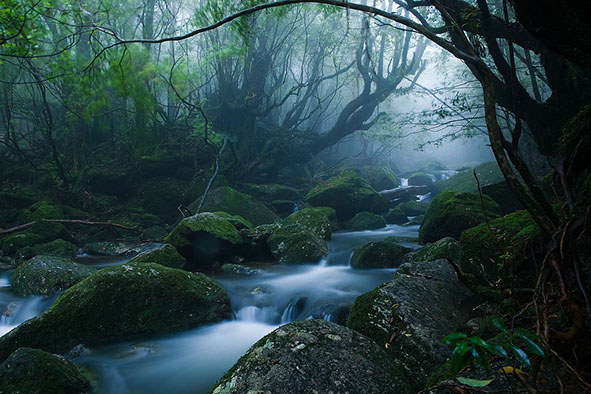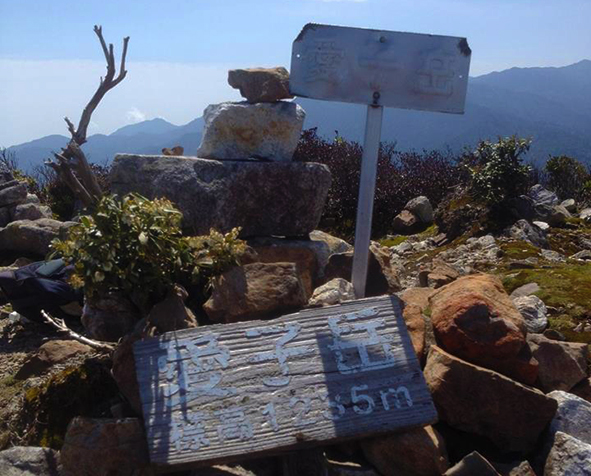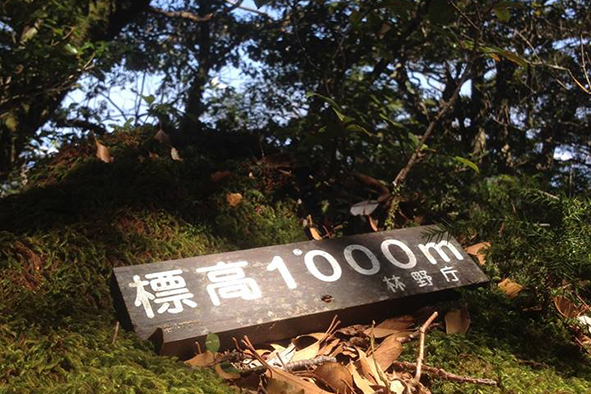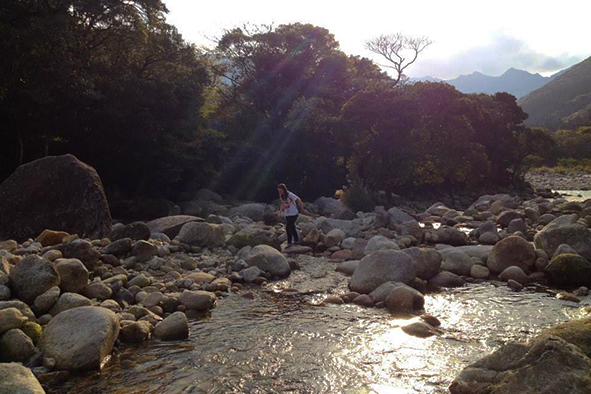To the south of Kyushu, Japan lies an extraordinary island – a place of UNESCO heritage listed forests teeming with life, vibrant folklore and epic hiking opportunities. Its name is Yakushima.

Mononoke Forest (Photo: Casey Yee via Flickr)
Yakushima is a mysterious island where the unexpected can happen at any time. It’s the only place in the world where monkeys casually ride on the backs of deer. It’s home to some of the oldest trees on the planet, said to be enchanted with spirits. And it was here, on an isolated mountain, that I found myself marooned on a steep forest slope, desperately scrambling over twisted roots in a vain effort to reconnect with the path. Caked in mud, smothered in moss and cut to shreds, I felt my energy sapping rapidly, as if the ground itself was claiming me for its own. As I began to fade, I traced back in my mind through my time in Yakushima.
An Island Out Of The Mist
I had travelled here days earlier, catching a ferry from Kagoshima city in Kyushu. Fringing the hull were schools of flying fish that glided beside us as if they considered the vessel their parent. En route the boat passed Sakurajima, a very much active volcano that regularly spews out great clouds of volcanic ash, which carpets the city of Kagoshima and eclipses the sky. All this added to the sense of mystery and adventure. A sense that anything could happen.
Yakushima erupts quite suddenly out of the ocean like a gargantuan green iceberg. Despite the soaring blue sky above us, it seemed to be perennially shrouded by a cloak of mist that obscured its rising peaks.
My hostel was situated conveniently close to one of two harbours on the island, complete with a veranda for watching the daily ferries chugging in and out. But the visitor who chooses to spend their time looking out from this island would be the fool indeed, for the true mystery and magic here lies deep within Yakushima.
The charming hostel host Hideki-San welcomed us with a glass of shochu, a strong spirit brewed from sweet potatoes which is favoured over sake this far south. He remarked on the exceptionally good weather, pointing out Yakushima’s reputation as Japan’s rainiest place. “We say, it rains here 366 days a year”, he jested. As different as our countries may be, I couldn’t help smiling at this connection between the Brits and Japanese – an obsession with the weather, along with a fondness for queueing and a penchant for a good knees-up.
Into The Forest
My first full day involved exploring a part of the island affectionately known as ‘Mononoke no mori’ – or ‘Mononoke Forest’. It was here that filmmaking legend Hayao Miyazaki drew inspiration for the iconic anime Princess Mononoke, where endearing little ‘Kodama’ – or forest spirits – appear out of thin air. It’s easy to see how Miyazaki found himself entranced by this woodland. Due to the near-constant rainfall, the abundance of moss and foliage seems to glimmer in an otherworldly emerald hue that has to be experienced to be believed.
The forest is crisscrossed by a series of babbling rivers and walking paths, frequented only by the occasional hiker armed with a camera. The main draw here is the collection of ancient sugi cedar trees which are interspersed throughout the forest. Gargantuan in size, the oldest of these is said to pre-date the Roman Empire. As these giants pass into the afterlife, their innards begin to rot away, allowing the explorer to climb inside the centuries old trunks. Immersed in this strange world, one could easily imagine the peculiar ‘Kodama’ creatures seen in Princess Mononoke peering out from behind a snarled root.
After a full day exploring the network of trails through Mononoke No Mori, I headed back down the winding road to the harbour below. A smattering of Yakushima monkeys and deer scattered playfully across the road as I travelled, as if caught in the act of doing something otherworldly. The night climaxed in true Yakushima style – with a shochu on the terrace beside the ocean waves.
Onto The Coast
I arose early the next day to experience a completely different side of Yakushima. I had learnt from Hideki-San that the forested, mountainous interior is near enough uninhabited, partly due to the practical difficulties of building roads and communities in such rough terrain, but also because of a long-held Shinto belief that within the mountains and the trees are spirits that mustn’t be disturbed. The small towns and villages that do exist here are peppered around the island’s circumference, which is fringed with beautiful white sand beaches.
I opted to cycle some way around Yakushima’s rim. Stopping for a breather on top of a hill, I found myself immersed in sunshine and dripping with sweat. To my right was a glittering beach lapped by a balmy ocean; to my left a mountain range that soared abruptly into the heavens. It is this sudden elevation that results in Yakushima’s unique and rather moist topography, as warm air floods in from the coast and tumbles up the mountain slopes, cooling rapidly and transforming into raincloud. It is perfectly possible in Yakushima for one individual to be sunbathing on the beach whilst another is simultaneously being lashed by an incessant storm in the mountains.
The cycle took me past more idyllic beaches and over fresh water rivers that stream down from the mysterious interior. These offered a cooling respite from the afternoon heat, with the added bonus that all of the fresh water in Yakushima is perfectly drinkable.
I had heard that to the south of Yakushima there existed a hot spring which bubbles up on a beach for just a short time whilst the tide is out, beckoning bathing enthusiasts. But without a vehicle this gem was unreachable, and with the knowledge that a glass of shochu awaited me on the terrace, I headed back to our hostel in the harbour.

Aiko Dake Summit (Photo: Dan Ayres)
Up Into The Mountains
On the recommendation from the knowledgeable Hideki-San, I decided it was time to conquer one of the mountains which had glared down at me since I stepped off the boat. Aiko-Dake is an archetypal mountain – a perfect triangular peak that pierces the sky like a challenge. There is a legend that on this mountain a girl named Aiko found herself plunging perilously into a river, only to be saved and subsequently abducted by monkeys, leading her bereft boyfriend to take his own life. Little did I know I would soon encounter my own perils up on Aiko-Dake.
Blessed with another uncharacteristically clear day, I was joined by two close friends and the three of us embarked upon the hike which began with a trail through the forest, marked only by a series of little pink ribbons that led the way like helpful fairies. The trail was steep, relentless and invigorating. It was also entirely void of humanity. There was a natural tranquility here the like of which seemed increasingly difficult to find in an ever more frantic and connected world. From time to time I would await my stubby-legged companions and take a breather on a mossy boulder or laze upon a tree branch, accompanied only by birdsong and the gentle breeze.
After hours of hiking the forest opened out and the final stretch stood before us – an exposed climb on the rock face of Aiko-Dake. Here, a series of helpfully placed ropes allowed us to scramble up to the summit and claim a glorious victory. The peak afforded breathtaking views; in one direction a series of lush green mountains seemed to stretch on for an eternity, in another the sandy bay collided with a sapphire ocean that eventually would lead back to Japan’s southernmost main island of Kyushu.
Down The Rabbit Hole
They say pride comes before a fall, a lesson I would learn on my descent. Giddy with success, I hurtled down the mountain at speed, leaving my companions far behind. But like the Aiko of the legend, the mountain was to lure me into a trap.
I came across a tree which had fallen from the side of the path steeply down into the thicket of woodland. I couldn’t resist clambering upon it to look further into the shadows. But it transpires a fallen tree, half rotten and sodden with months of rainfall, is nature’s very own lubricated death-slide. Like Alice tumbling down the rabbit hole, I abruptly slid down into the depths of the forest below.
Panicked, exhausted and entirely alone, I desperately attempted to scramble back up the moistened bark, but to no avail. I felt like a turtle trying to clamber up a water slide. I decided to leap onto the slope beneath the tree, but it was so steep and carpeted with gnarled roots that I quickly became ensnared.
Here, the flashbacks ensued: conquering the mountain peak moments before, cycling the balmy coastline, plunging into the icy water, exploring the hollow trees which predated empires, and then, Yakushima itself, rising like a God from the ocean. The island that had given me so much and was now threatening to take it all away.
Eventually, two faces poked out from the path far above me, and began cackling maniacally. In my delirium, I assumed the monkeys that claimed Aiko had finally come to kidnap me and claim me as their own. But no, it was my plodding friends who, oddly enough, found my situation entirely hilarious. After much merciless mockery, they eventually took pity on me and helped drag me through series of roots that formed a kind of forested orifice that opened back out onto the path. I emerged bloodied, muddied, sheepish and humbled. The incident has hitherto been referred to as my “rebirth.”
That night I found myself back on the terrace, licking my wounds, looking out to the tumbling ocean and nursing a well-deserved final shochu. I reflected upon Yakushima, the obscenely green ancient island that had enchanted me, enraptured me, challenged me and even sort of given birth to me. It seemed to me that a trip to Yakushima was the closest thing one can get to visiting a fantasy land on earth – one where the only real thing you can count upon is being surprised.

